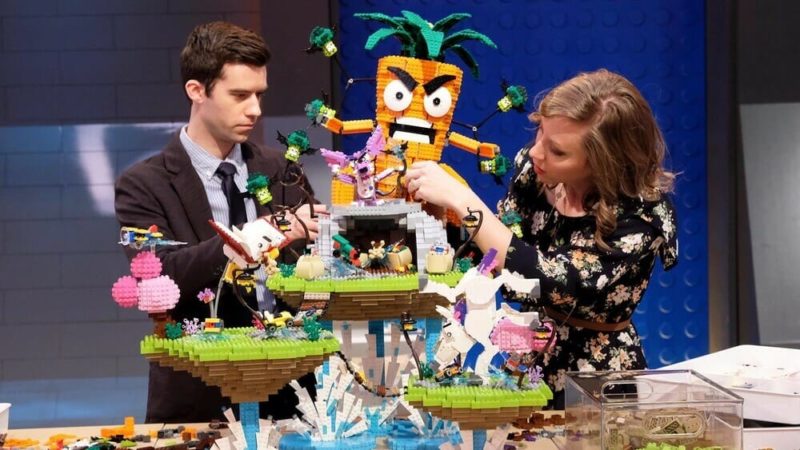LEGO Facts That Will Turn You Into a LEGO Master
 FOX
FOX Reading Time: 4 minutes
LEGO Masters season two premieres tonight on Fox. The exciting brick building competition is sure to shock and awe with more insane and imaginative challenges. While you don’t have to be an AFOL (Adult Fan of LEGO) to enjoy watching the show, it might be nice to gain some LEGO knowledge ahead of the premiere. Here are some facts we dug up around the company and the show that you may not know.
LEGO Fun Facts
1) The Origin of the Show
It should come as no surprise if you’re an avid watcher of television, this show is adapted from a show of the same name from the UK. The show first aired in August 2017 and proved to be successful. The U.S. version is not the only international adaptation since then, now the show is produced for 11 markets globally, with Denmark and Finland just signing on for future adaptations themselves.
2) LEGO Masters Need Bricks
A competition of this type is no short order. With some of the small LEGO sets coming with 100 pieces, sourcing enough bricks for 10 teams to build entire amusement parks must be in the thousands. Wrong! The set’s “Brick Pit” holds roughly 3.3 million bricks, minifigs, and other LEGO parts for teams to pick through! All sorted and organized to make finding the pieces they need that much easier. Great for the builders, but for production, it equals 12 hour days, five-six days a week separating and replenishing the Brick Pit after each challenge is complete.

3) Building the Set
We’re not talking about building a LEGO set, we’re talking about building the LEGO Masters set. Before even the first challenge, LEGO has been being snapped together to build the set, props, and challenge elements. A full team lead by the world-renowned LEGO artist Nathan Sawaya, who’s recognized by the company as one of the best builders in the world, is responsible for every constructed LEGO element you see on set. Due to the Covid-19 pandemic, this task became more challenging for the upcoming season two with only a two-person team to do all that work.
4) Humble Beginnings
LEGO got its humble beginning in Billund, Denmark back in 1932. Master carpenter Ole Kirk Kristiansen started as a one-man toy factory, making wooden toys of the highest craftsmanship. His humility made him a bad salesman for his toys but eventually grew popular for his quality. It would be nearly two decades before ever working with plastic which lead to the iconic bricks we know today.
5) Learn to Play
Ole Kirk Kristiansen didn’t name his toy company for the first few years. With the thought that a good name could help the company sell more toys, he began thinking of one that expressed his toy making dreams. In 1935 LEGO was born! The name is a combination of two Danish words, “leg” and “godt,” which translates to “play well.” The wordplay embodies Ole’s vision of commitment toward children’s development through play. Ironically and unknown by Ole at the time, the word “lego” in Latin means “I put together.”

6) A Star is Born
The wooden toy company had whittled their toys for nearly 15 years. As the technology evolved, Ole began to experiment with plastic injection molding seeing its potential. After a few years and having to convince his sons of his vision, LEGO launched the predecessor to the bricks we now know. “Automatic binding bricks” back then, the bricks were still only a product and not the cornerstone for the entire company.
7) As Limitless as it is Timeless
LEGO continued to develop on the plastic brick concept. They even have a patent on the brick’s coupling system that we know today. The brick’s proprietary interlocking studs and tubes design allowed two blocks to join in 24 different ways. Just six blocks can combine in 102,981,500 ways! The LEGO brick we know today is over 60 years old, and the first bricks made in 1958 would still fit one made today.

8) Talk About Minimizing Waste
In its more than 60 years of producing the LEGO bricks, the company has now made over 320 billion individual bricks! That’s a crazy number to imagine but even crazier is how many bricks come out not meeting the company’s standards. The mold used to produce the bricks has an accuracy within two-thousandth of a millimeter (0.002 mm.) The precision leaves roughly 18 bricks out of every million produced as not meeting the high-quality standards. If you’re doing the math, that’s about 5,760,000 (not even 1%) bricks that haven’t made the cut.
Watch LEGO Masters
Season two of Lego Masters premieres Tuesday June 1 at 8 p.m. on Fox. You won’t want to miss a single challenge so be sure to tune in.















Please tell me how to acculey be a Lego master very disappointing